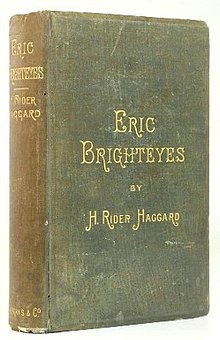Eric Brighteyes
 First edition (publ. Longman) | |
| Author | H. Rider Haggard |
|---|---|
| Country | United Kingdom |
| Language | English |
| Publisher | Longmans & Co. |
Publication date | 1890 |
Eric Brighteyes is an epic viking novel by H. Rider Haggard that concerns the adventures of its eponymous principal character in 10th-century Iceland. The novel was first published in 1890 by Longmans, Green & Company. It was illustrated by Lancelot Speed.
Plot outline[]
Eric Thorgrimursson, nicknamed "Brighteyes" for his most notable trait, strives to win the hand of his beloved, Gudruda the Fair. Her father Asmund, a priest of the old Norse gods, opposes the match, believing Eric to be a man without prospects. Deadlier by far are the intrigues of Swanhild, Gudruda's half-sister and a sorceress, who desires Eric for herself. She persuades the chieftain Ospakar Blacktooth to woo Gudruda, making the two men enemies. Battles, intrigues, and treachery follow.
Background[]
Haggard wrote the book in late 1888, following a visit to Iceland.[1]
Pioneer of the genre[]
The novel was an early example (and Haggard's introduction implies that it was the first) of modern efforts in English at pastiching saga literature. It clearly shows the influence of the pioneering saga translations by William Morris and Eirikr Magnusson in the late 1860s.
Anthony Boucher and J. Francis McComas praised Eric Brighteyes, saying that "nothing has been written in English that matches this complete comprehension of the blend of the fury and mysticism that was that greatest of anomalies, the Viking."[2] Pamela Cleaver described Eric Brighteyes as the best of Haggard's historical novels. She stated that "there is a wonderful atmosphere with saga overtones in this doom-laden tale."[3]
The novel was republished by the Newcastle Publishing Company under the title The Saga of Eric Brighteyes as the second volume of the Newcastle Forgotten Fantasy Library series in March, 1974, and first issued as a mass market paperback by Zebra Books in 1978.[4]
In The Stanley Kubrick Archive Oral History Project Web Video Series "Finding and Developing the Story", Kubrick's eldest daughter Katharina mentions the book as one that "he was particularly interested in". Anthony Frewin states the book was "very, very dear to him" and claims that, "had he lived, I'm sure he would have done it" as a film.[5]
References[]
- ^ H Rider Haggard, The Days of My Life Chapter 13 accessed 21 December 2013
- ^ "Recommended Reading," F&SF, September 1953, p. 100.
- ^ Cleaver, Pamela. "Haggard, H(enry) Ridger". In Henderson, Lesley, and Kirkpatrick, Daniel Lane. In Twentieth-century Romance and Historical Writers. Chicago : St James Press, 1990. ISBN 9780912289977 (pg. 298)
- ^ ISFDB publishing history
- ^ The Stanley Kubrick Archive Oral History Project: Finding and Developing the Story
External links[]
- Eric Brighteyes at Project Gutenberg
- Online version on The Literature Network
 Eric Brighteyes public domain audiobook at LibriVox
Eric Brighteyes public domain audiobook at LibriVox- Images and bibliographic information for various editions of Eric Brighteyes at SouthAfricaBooks.com
| Wikisource has original text related to this article: |
- 1890 British novels
- 1890 fantasy novels
- British fantasy novels
- Historical novels
- Novels by H. Rider Haggard
- Novels set in Iceland
- Fictional Vikings
- Novels set in the Viking Age